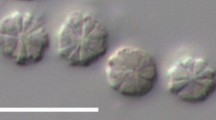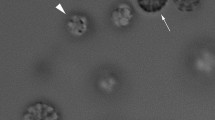Abstract
Magnetotactic bacteria move by rotating their flagella and concomitantly are aligned to magnetic fields because they present magnetosomes, which are intracellular organelles composed by membrane-bound magnetic crystals. This results in magnetotaxis, which is swimming along magnetic field lines. Magnetotactic bacteria are morphologically diverse, including cocci, rods, spirilla and multicellular forms known as magnetotactic multicellular prokaryotes (MMPs). ‘Candidatus Magnetoglobus multicellularis’ is presently the best known MMP. Here we describe the helical trajectories performed by these microorganisms as they swim forward, as well as their response to UV light. We measured the radius of the trajectory, time period and translational velocity (velocity along the helix axis), which enabled the calculation of other trajectory parameters such as pitch, tangential velocity (velocity along the helix path), angular frequency, and theta angle (the angle between the helix path and the helix axis). The data revealed that ‘Ca. M. multicellularis’ swims along elongated helical trajectories with diameters approaching the diameter of the microorganism. In addition, we observed that ‘Ca. M. multicellularis’ responds to UV laser pulses by swimming backwards, returning to forward swimming several seconds after the UV laser pulse. UV light from a fluorescence microscope showed a similar effect. Thus, phototaxis is used in addition to magnetotaxis in this microorganism.




Similar content being viewed by others
References
Abreu F, Silva KT, Martins JL, Lins U (2006) Cell viability in magnetotactic multicellular prokaryotes. Int Microbiol 9:267–272
Abreu F, Martins JL, Silveira TS, Keim CN, de Barros HGPL, Gueiros-Filho F, Lins U (2007) ‘Candidatus Magnetoglobus multicelularis’, a multicellular, magnetotactic prokaryote from a hypersaline environment. Int J Syst Evol Microbiol 57:1318–1322
Berg HC, Purcell EM (1977) Physics of chemoreception. Biophys J 20:193–219
Blake JR, Sleigh MA (1974) Mechanics of ciliary locomotion. Biol Rev 49:85–125
Crenshaw HC (1989) Kinematics of helical motion of microorganisms capable of motion with four degrees of freedom. Biophys J 56:1029–1035
De Araujo FFT, Germano FA, Gonçalves LL, Pires MA, Frankel RB (1990) Magnetic polarity fractions in magnetotactic bacterial populations near the geomagnetic equator. Biophys J 58:549–555
DeLong EF, Frankel RB, Bazylinski DA (1993) Multiple evolutionary origins of magnetotaxis in bacteria. Science 259:803–806
Diehn B, Feinleib M, Haupt W, Hildebrand E, Lenci F, Nultsch W (1977) Terminology of behavioral responses of motile microorganisms. Photochem Photobiol 26:559–560
Drescher K, Goldstein RE, Tuval I (2010) Fidelity of adaptive phototaxis. Proc Nat Acad Sci USA 107:11171–11176
Esquivel DMS, de Barros HGPL (1986) Motion of magnetotactic microorganisms. J Exp Biol 121:153–163
Faivre D, Schüler D (2008) Magnetotactic bacteria and magnetosomes. Chem Rev 108:4875–4898
Farina M, de Barros HL, Esquivel DMS, Danon J (1983) Ultrastructure of a magnetotactic microorganism. Biol Cell 48:85–88
Fenchel T (1994) Motility and chemosensory behavior of the sulfur bacterium Thiovulum majus. Microbiology 140:3109–3116
Fenchel T, Thar R (2004) “Candidatus Ovobacter propellens”: a large conspicuous prokaryote with an unusual motility behaviour. FEMS Microbiol Ecol 48:231–238
Frankel RB, Bazylinski DA, Johnson MS, Taylor BL (1997) Magneto-aerotaxis in marine coccoid bacteria. Biophys J 73:994–1000
Frankel RB, Williams TJ, Bazylinski DA (2007) Magneto-aerotaxis. In: Schüler D (ed) Magnetoreception and magnetosomes in bacteria. Springer, Berlin, Heidelberg, pp 1–24
Gest H (1995) Phototaxis and other sensory phenomena in purple photosynthetic bacteria. FEMS Microbiol Rev 16:287–294
Gomelsky M, Hoff WD (2011) Light helps bacteria make important lifestyle decisions. Trends Microbiol 19:441–448
Greenberg M, Canter K, Mahler I, Tornheim A (2005) Observation of magnetoreceptive behavior in a multicellular magnetotactic prokaryote in higher than geomagnetic fields. Biophys J 88:1496–1499
Häder D-P (1987) Photosensory behavior in prokaryotes. Microbiol Rev 51:1–21
He Y–Y, Häder D-P (2002) Reactive oxygen species and UV-B: effect on cyanobacteria. Photochem Photobiol Sci 1:729–736
Jarrell KF, McBride MJ (2008) The surprisingly diverse ways that prokaryotes move. Nat Rev Microbiol 6:466–476
Johansen JE, Pinhassi J, Blackburn N, Zweifel UL, Hagström A (2002) Variability in motility characteristics among marine bacteria. Aquat Microb Ecol 28:229–237
Keim CN, Lutterbach LG, Farina M (2003) Crystallization of NaCl and CaCO3 from solution using magnetotactic bacteria as laser beam energy absorbers under the optical tweezers microscope. Microsc Microanal 9(suppl. 2):248–249
Keim CN, Abreu F, Lins U, de Barros HL, Farina M (2004a) Cell organisation and ultrastructure of a magnetotactic multicellular organism. J Struct Biol 145:254–262
Keim CN, Martins JL, Abreu F, Rosado A, Farina M, de Barros HL, Borojevic R, Lins U (2004b) Multicellular life cycle of magnetotactic prokaryotes. FEMS Microbiol Lett 240:203–208
Keim CN, Martins JL, de Barros HL, Lins U, Farina M (2007) Structure, behavior, ecology and diversity of multicellular magnetotactic prokaryotes. In: Schüler D (ed) Magnetoreception and magnetosomes in bacteria. Springer, Berlin, Heidelberg, pp 103–132
Krell T, Lacal J, Muñoz-Martínez F, Reyes-Darias JA, Cadirci BH, García-Fontana C, Ramos JL (2011) Diversity at its best: bacterial taxis. Environ Microbiol 13:1115–1124
Larsen SH, Reader RW, Kort EN, Tso W–W, Adler J (1974) Change in direction of flagellar rotation is the basis for chemotactic response in Escherichia coli. Nature 249:74–77
Lefèvre C, Bernadac A, Pradel N, Wu L, Yu-Zhang K, Xiao T, Yonnet J-P, Lebouc A, Song T, Fukumori Y (2007) Characterization of mediterranean magnetotactic bacteria. J Ocean Univ China 6:355–359
Lefèvre CT, Bernadac A, Yu-Zhang K, Pradel N, Wu L-F (2009) Isolation and characterization of a magnetotactic bacterial culture from the Mediterranean Sea. Environ Microbiol 11:1646–1657
Lefèvre CT, Abreu F, Lins U, Bazylinski DA (2010) Nonmagnetotactic multicellular prokaryotes from low-saline, nonmarine aquatic environments and their unusual negative phototactic behavior. Appl Environ Microbiol 76:3220–3227
Lefèvre CT, Frankel RB, Abreu F, Lins U, Bazylinski DA (2011) Culture-independent characterization of a novel, uncultivated magnetotactic member of the Nitrospirae phylum. Environ Microbiol 13:538–549
Lefèvre CT, Viloria N, Schmidt ML, Pósfai M, Frankel RB, Bazylinski DA (2012) Novel magnetite-producing magnetotactic bacteria belonging to the Gammaproteobacteria. ISME J 6:440–450
Lins U, Farina M (1999) Organization of cells in magnetotactic muticellular aggregates. Microbiol Res 154:9–13
Lins U, Freitas F, Keim CN, de Barros HL, Esquivel DMS, Farina M (2003) Simple homemade apparatus for harvesting uncultured magnetotactic microorganisms. Brazilian J Microbiol 34:111–116
Lins U, Keim CN, Evans FF, Farina M, Buseck PR (2007) Magnetite (Fe3O4) and greigite (Fe3S4) crystals in magnetotactic multicellular organisms. Geomicrobiol J 24:43–50
Lowe G, Meister M, Berg HC (1987) Rapid rotation of flagellar bundles in swimming bacteria. Nature 325:637–640
Martins JL, Silveira TS, Silva KT, Lins U (2009) Salinity dependence of the distribution of multicellular magnetotactic prokaryotes in a hypersaline lagoon. Int Microbiol 12:193–201
Mello TBM (2007) Caracterização biogeoquímica da Lagoa de Araruama, RJ. Dissertation, Universidade Federal Fluminense, Brazil
Mitchell JG, Kogure K (2006) Bacterial motility: links to the environment and a driving force for microbial physics. FEMS Microbiol Ecol 55:3–16
Nogueira FS, de Barros HGPL (1995) Study of the motion of magnetotactic bacteria. Eur Biophys J 24:13–21
Pan Y, Lin W, Li J, Wu W, Tian L, Deng C, Liu Q, Zhu R, Winklhofer M, Petersen N (2009) Reduced efficiency of magnetotaxis in magnetotactic coccoid bacteria in higher than geomagnetic fields. Biophys J 97:986–991
Perantoni M, Esquivel DMS, Wajnberg E, Acosta-Avalos D, Cernicchiaro G, de Barros HL (2009) Magnetic properties of the microorganism Candidatus Magnetoglobus multicellularis. Naturwissenschaften 96:685–690
Rodgers FG, Blakemore RP, Blakemore NA, Frankel RB, Bazylinski DA, Maratea D, Rodgers C (1990) Intercellular structure in a many-celled magnetotactic prokaryote. Arch Microbiol 154:18–22
Schleifer K-H, Schüler D, Spring S, Weizenegger M, Amann R, Ludwig W, Kohler M (1991) The genus Magnetospirillum gen. nov. Description of Magnetospirillum gryphiswaldense sp. nov.; and transfer of Aquaspirillum magnetotacticum to Magnetospirillum magnetotacticum comb. nov. Syst Appl Microbiol 14:379–385
Schulz HN, Jørgensen BB (2001) Big bacteria. Annu Rev Microbiol 55:105–137
Shapiro OH, Hatzenpichler R, Buckley DH, Zinder SH, Orphan VJ (2011) Multicellular photo-magnetotactic bacteria. Environ Microbiol Rep 3:233–238
Silva KT, Abreu F, Almeida FP, Keim CN, Farina M, Lins U (2007) The flagellar apparatus of south-seeking many-celled magnetotactic prokaryotes. Microsc Res Tech 70:10–17
Simmons SL, Bazylinski DA, Edwards KJ (2006) South-seeking magnetotactic bacteria in the Northern Hemisphere. Science 311:371–374
Spring S, Amann R, Ludwig W, Schleifer KH, Petersen N (1992) Phylogenetic diversity and identification of nonculturable magnetotactic bacteria. Syst Appl Microbiol 15:116–122
Spring S, Amann R, Ludwig W, Schleifer K-H, Gemerden H, Petersen N (1993) Dominating role of an unusual magnetotactic bacterium in the microaerobic zone of a freshwater sediment. Appl Environ Microbiol 59:2397–2403
Steinmetz M (1989) Thermal origin during excimer laser interaction with tissue. Ber Bunsenges Phys Chem 93:293–295
Vogel A, Lorenz K, Horneffer V, Hüttmann G, Smolinski D, Gebert A (2007) Mechanisms of laser-induced dissection and transport of histologic specimens. Biophys J 93:4481–4500
Wenter R, Wanner G, Schüler D, Overmann J (2009) Ultrastructure, tactic behaviour and potential for sulfate reduction of a novel multicellular magnetotactic prokaryote from North Sea sediments. Environ Microbiol 11:1493–1505
Winklhöfer M, Abraçado LG, Davila AF, Keim CN, de Barros HGPL (2007) Magnetic optimization in a multicellular magnetotactic organism. Biophys J 92:661–670
Yang C, Chen C, Ma Q, Wu L, Song T (2012) Dynamic model and motion mechanism of magnetotactic bacteria with two lateral flagellar bundles. J Bionic Eng 9:200–210
Zhang W-J, Chen C, Li Y, Song T, Wu L-F (2010) Configuration of redox gradient determines magnetotactic polarity of the marine bacteria MO-1. Environ Microbiol Rep 2:646–650
Zhou K, Pan H, Zhang S, Yue H, Xiao T, Wu L-F (2011) Occurrence and microscopic analyses of multicellular magnetotactic prokaryotes from coastal sediments in the Yellow Sea. Chin J Oceanol Limnol 29:246–251
Zhou K, Zhang W-Y, Yu-Zhang K, Pan H-M, Zhang S-D, Zhang W-J, Yue H-D, Li Y, Xiao T, Wu L-F (2012) A novel genus of multicellular magnetotactic prokaryotes from the Yellow Sea. Environ Microbiol 14:405–413
Zhu K, Pan H, Li J, Yu-Zhang K, Zhang S-D, Zhang W-Y, Zhou K, Yue H, Pan Y, Xiao T, Wu L-F (2010) Isolation and characterization of a marine magnetotactic spirillum axenic culture QH-2 from an intertidal zone of the China Sea. Res Microbiol 161:276–283
Acknowledgments
We are grateful to Leida Gomes Abraçado, Carlos Van Der Ley and Karen T. Silva for help in adaptation of the coils to the microscope. This work was supported by the Brazilian agencies CNPq (Conselho Nacional de Desenvolvimento Científico e Tecnológico), CAPES (Coordenação de Aperfeiçoamento de Pessoal de Nível superior) and FAPERJ (Fundação Carlos Chagas Filho de Amparo a Ciência no Estado do Rio de Janeiro).
Author information
Authors and Affiliations
Corresponding author
Electronic supplementary material
Below is the link to the electronic supplementary material.
Supplementary material 2 (MPG 5068 kb)
Rights and permissions
About this article
Cite this article
Almeida, F.P., Viana, N.B., Lins, U. et al. Swimming behaviour of the multicellular magnetotactic prokaryote ‘Candidatus Magnetoglobus multicellularis’ under applied magnetic fields and ultraviolet light. Antonie van Leeuwenhoek 103, 845–857 (2013). https://doi.org/10.1007/s10482-012-9866-0
Received:
Accepted:
Published:
Issue Date:
DOI: https://doi.org/10.1007/s10482-012-9866-0




